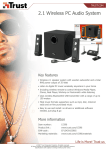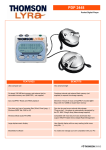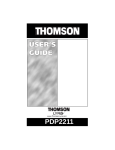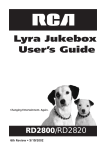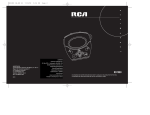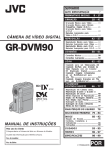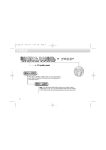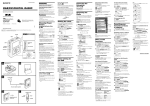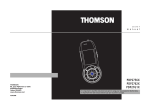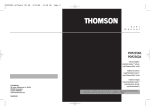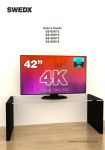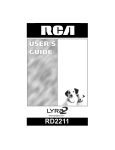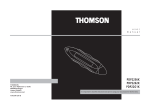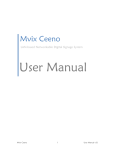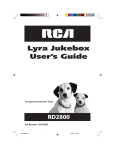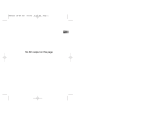Download Technicolor - Thomson PDP2222 User's Manual
Transcript
et pock stop rew THOMSON multimedia 46/47 quai A. Le Gallo 92648 Boulogne Cedex FRANCE RCS nanterre B 322 019 464 55137170 www.thomson-multimedia.com u s e r m a n u a ayer l pl gita ay i d t pl ocke d op rew fw l PDP2222 Important Information Warning • Do not play your headset at a high volume. Hearing experts warn against extended high-volume play. • If you experience a ringing in your ears, reduce volume or discontinue use. • You should use extreme caution or temporarily discontinue use in potentially hazardous situations. Even if your headset is an open-air type designed to let you hear outside sounds, don’t turn up the volume so high that you are unable to hear what is around you. Caution While Driving: Use of headphones while operating an automobile or moving vehicle is not recommended and is unlawful in some states and areas. Be careful and attentive on the road. Stop operation of the unit if you find it disruptive or distracting while driving. Precautions for the Unit • Do not use the unit immediately after transportation from a cold place to a warm place; condensation problem may result. • Avoid shock to the unit especially during recording. Recorded data may be damaged. • Do not store the unit near fire, places with high temperature or in direct sunlight. • Do not operate or store unit in places with frequent static electricity or electrical noise (e.g. speaker, TV set). • Clean the unit with a soft cloth or a damp chamois leather. Never use solvents. • The unit must only be opened by qualified personnel. Warning: Use of this product is for your personal use only. Copying CDs or downloading music files for sale or other business purposes is a violation of copyright law. It is also a violation of copyright law to download files without permission of the copyright owner. Important Information Care of MultiMediaCards • Do not touch the golden electrodes. Use a soft dry cloth to clean any dirt. • Do not bend MultiMediaCards. • Do not operate or store MultiMediaCards in places with frequent static electricity or electrical noise (e.g. speaker, TV set). Recorded data may be damaged. • It is normal for MultiMediaCards to get warm after being used for a long time. • Always put it in storage case after removing from the unit. • Do not store MultiMediaCards near fire, places with high temperature/ humidity or in direct sunlight. • We recommend that you make a copy of your recorded contents into another media (e.g. floppy disc, tape) as back-up. Power supply • Battery power: AAA (LR03) x 2. Battery Precautions • When storing the unit , be sure to remove the batteries because they may leak and damage the unit. • Batteries may leak electrolyte if inserted incorrectly, if disposed of in fire, or if an attempt is made to charge a battery not intended to be recharged. • Never mix new batteries with old ones. Do not mix battery types. • Discard leaky batteries immediately. Leaking batteries may cause skin burns or other personal injury. • Do not charge batteries which are not intended to be recharged. • Dispose of batteries, according to federal, state and local regulations. The descriptions and characteristics given in this document are given as a general indication and not as a guarantee. In order to provide the highest quality product possible, we reserve the right to make any improvement or modification without prior notice. The English version serves as the final reference on all product and operational details should any discrepancies arise in other languages. EN Important Safety Information IMPORTANT NOTE: To reduce the risk of fire or shock hazard, do not expose this player to rain or moisture. CAUTION RISK OF ELECTRIC SHOCK DO NOT OPEN This symbol indicates “dangerous voltage” inside the product that presents a risk of elecrtric shock or personal injury. ATTENTION RISQUE DE CHOC ELECTRIQUE NE PAS OUVRIR This symbol indicates important instructions accompanying the product. TO REDUCE THE RISK OF ELECTRIC SHOCK, DO NOT REMOVE THE COVER (OR BACK). NO USER-SERVICEABLE PARTS ARE INSIDE. REFER SERVICING TO THE QUALIFIED SERVICE PERSONNEL. Sound Pressure Control Les articles de loi L44.5 et 44.6 du code de la santé publique, modifiés par l’article 2 de la loi du 28 Mai 1996 imposent une puissance acoustique maximale de 100 décibels. Le casque livré ( code 55110130 ) et votre appareil respectent la législation en vigueur. A pleine puissance, l’écoute prolongée du baladeur peut endommager l’oreille de l’utilisateur. Table of Content Important Information 10. Use MusicMatch Jukebox To Play Radio On Your PC . . . . . . . . . . .14 Before You Begin . . . . . . . . . . . .1 11. Organize The Music Library . . . .16 What’s So Special About This MP3 Player? . . . . . . . . . . . . . . . . . . . . . . . . .1 12. Create a Playlist For Playing Or Downloading . . . . . . . . . . . . . . . . . . .17 Computer System Requirements . . . .1 13. Edit Tags For Your Songs . . . . . .19 Getting Started . . . . . . . . . . . . .2 14. Transfer The Audio Files To Thomson Lyra Pocket Player . . . . . .20 1. Insert The Included Software CD Into your CD-ROM Drive . . . . . . . . . .2 15. Install The RealJukeboxTM Software . . . . . . . . . . . . . . . . . . . . . . .23 2. Install The USB Drivers . . . . . . . . . .3 16. Set Basic Preferences . . . . . . . . .24 3. Connect Thomson Lyra Pocket Player To Computer . . . . . . . . . . . . . . . . . . . .3 17. Learn the RealJukebox Basic Controls . . . . . . . . . . . . . . . . . . . . . . .27 4. Install The Music Management Software . . . . . . . . . . . . . . . . . . . . . . . .4 18. Save CD Tracks To Play On Your PC Or In Your Thomson Lyra Pocket Player . . . . . . . . . . . . . . . . . . . . . . . . .28 5. Install The MusicMatch JukeboxTM Software . . . . . . . . . . . . . . . . . . . . . . . .5 6. Set MusicMatch Jukebox Basic Preferences . . . . . . . . . . . . . . . . . . . . .7 7. Learn The MusicMatch Jukebox Basic Controls . . . . . . . . . . . . . . . . . .11 8. Save CD Tracks To Play On Your PC Or In Your Thomson Lyra Pocket 12 9. Download Music From The Internet . . . . . . . . . . . . . . . . . . . . . . .14 MusicMatch Jukebox is a trademark of MusicMatch, Inc. RealJukebox is a trademark of Real Networks, Inc. 19. Download Music From The Internet . . . . . . . . . . . . . . . . . . . . . . .29 20. Organize The Playlist . . . . . . . . .30 21. Create A Playlist For Playing Or Downloading . . . . . . . . . . . . . . . . . . .31 EN Table of Content 22. Create An Auto-Playlist . . . . . . .32 Programming Tracks . . . . . . . . . . . . .42 23. Searching For Tracks . . . . . . . . . .32 Editing Program . . . . . . . . . . . . . . . .43 24. Radio . . . . . . . . . . . . . . . . . . . . . .33 Key Lock . . . . . . . . . . . . . . . . . . . . . . .43 25. Transfer The Audio Files To Thomson Lyra Pocket Player . . . . . . . . . . . . . . .34 File Download . . . . . . . . . . . . . . . . . .43 26. Install Thomson Lyra Pocket User’s Guide And Documentation . . . . . . .36 Before You Begin . . . . . . . . . . .37 1. Insert Batteries Into The Player . .37 2. Inserting A MultiMedia Card (Optional) . . . . . . . . . . . . . . . . . . . . . .38 3. Using Headphones . . . . . . . . . . . .38 General Controls . . . . . . . . . . . .39 Display . . . . . . . . . . . . . . . . . . .40 Operation . . . . . . . . . . . . . . . . .41 General Operation . . . . . . . . . . . . . .41 DSP . . . . . . . . . . . . . . . . . . . . . . . . . . .42 Play Modes . . . . . . . . . . . . . . . . . . . . .42 Troubleshooting Tips . . . . . . . .44 Before You Begin What’s so special about this MP3 player? EN This player is meant to play MP3 files encoded on a memory card or recorded in the built-in flash memory. To do so, you need the use of a Windows computer with USB connection, USB cable (included) and a music management software (MusicMatch Jukebox recommended). CDs Compression and transfer and/or Playback MusicMatch Jukebox pocket digital player sto y p r pla ew fw d USB cable Compressed music internet sites www.thomson-lyra.com, www.lyrazone.com www.thomson-music.com, www.musicmatch.com, MP3 music in MultiMediaCard or built-in flash memory Computer System Requirements Minimum Optimum • Pentium 233 MHz or faster • 64 MB RAM • Windows* 98, Windows Me or Windows 2000 • 45 MB free hard disk space plus 1 MB for every minute of CD quality music you store on your hard drive • CD-ROM Drive • USB Port • Full Duplex Sound Card • Pentium II 300 MHz or faster • 128 MB RAM • Windows 98SE, Windows Me or Windows 2000 • 50 MB free hard disk space plus 1 MB for every minute of CD quality music you store on your hard drive • CD-ROM Drive • USB Port • Full Duplex Sound Card • Internet Explorer 4.0 or more with latest access * Windows and Microsoft are registered trademarks of Microsoft Corporation in the United States and/or other countries. 1 Getting Started 1. Insert the included software CD into your CD-ROM drive. Use the software setup program on the included CD to install the USB drivers, Music Management software, and User’s guide and documentation. A. Turn on your computer and insert the software CD. Thomson Lyra Pocket Software Setup program will automatically run. Note: If the setup screen does not appear, double click My Computer, double click your CD-ROM drive icon, and double click setup.exe. You can also click , Run, then type D:\setup.exe (where D is the letter of your CD-ROM drive). 2 B. Click Next to display the Select Components screen. Getting Started EN 2. Install the USB drivers. A. Click the Install Universal Serial Bus Drivers button and follow the on-screen instructions to install the drivers. B. Restart your computer (if prompted). 3. Connect Thomson Lyra Pocket player to computer A. Make sure you have installed the USB drivers and that your computer has been restarted (if necessary). C. Windows will automatically install the drivers for the external drive after you connect it. B. Once the computer has been restarted, connect the mini-USB (small) connector to Thomson Lyra Pocket player, connect the Type-A (large) connector to an available USB port of your computer as shown below. Note: Consult your computer or device’s owner manual for USB port specifications and troubleshooting. max volume min pocket digital player sto p r lay ew fw d p Thomson Lyra Pocket player will display the icon when USB cable is properly connected. PC PHONES 3 Getting Started 4. Install the music management software. MusicMatch Jukebox and RealJukebox software are included on Thomson Lyra Pocket software CD. We recommend MusicMatch Jukebox for ease of use and functionality. Both software programs operate as players on your PC, compress CDs to MP3 format, download files from the Internet, and transfer the files to your Thomson Lyra Pocket player. Download MP3 files to the player with the MusicMatch Jukebox software and RealJukebox software. Install one or both of these programs. A. Insert Thomson Lyra Pocket software disc into your CD-ROM drive. Follow the directions under Step 1 to display the Select Components screen. C. Select the software you want to install and click Install. • Select MusicMatch Jukebox (Recommended) to install the MusicMatch Jukebox software. MusicMatch Jukebox is capable of MP3, WAV, and Windows MediaTM audio format compression. Go to Step 5. B. Click the Install the Music Management Software icon to display the Select Music Software screen. • Select RealJukebox to install the RealJukebox software. RealJukebox is capable of MP3, wave, and RealAudio8 with ATRAC3 compression. Go to Step 15. 4 Getting Started EN 5. Install the MusicMatch Jukebox™ software. Helpful Hint It is recommended to uninstall any previous installations of the MusicMatch Jukebox software before preceding with the Getting Started process. After the uninstall process has been completed, it is also recommended to delete the C:\Program Files\MusicMatch folder from Windows as well where C:\Program Files is the path where the software was installed. A. Display the Select Music Software screen as described in Step 4. B. Make sure MusicMatch Jukebox is highlighted and click Install. C. QUICKSTART screen will appear after installation has started. Click on Install MusicMatch Jukebox 5.1. 5 Getting Started 5. Install the MusicMatch Jukebox™ software. (continued) D. Click Yes to accept or No to decline after you have read the license agreement. You must click Yes to continue. F. Click Next to display Personalize Net Music screen. E. When the next screen appears, enter your Name, E-mail address, Postal code, Country, Year of Birth, and sex (Male or Female). G. Read the screen and decide if you would like to enable the PERSONALIZE NET MUSIC feature. Select Yes or No. This setting can be changed later. Notes: Enter an E-mail address or [email protected] if you don’t have E-mail. You must enter an Email address to proceed. If you do not want to be informed of program updates or receive news and offers via E-mail, uncheck the boxes. 6 Getting Started EN 5. Install the MusicMatch Jukebox™ software. (continued) H. Click Next to display Installation Options dialog. Select the installation option you wish to use. Express Setup is recommended. Click Next to continue. If necessary, close the main setup screen. I. After the installation is complete, click Finish to complete setup. You may need to restart your web browser. Reboot your computer if any other software was installed specifically USB drivers. 6. Set MusicMatch Jukebox basic preferences. Detailed information, Welcome Tips, and troubleshooting are available through the Help menu and the MusicMatch Internet site (accessed from the Help and Sites menus). We recommend you familiarize yourself with the MusicMatch Welcome Tips and view the Online FAQ’s before using and recording files. Logging onto the Internet while using MusicMatch Jukebox takes advantage of all its features. We feel a few of the Recording Settings options need to be discussed before you start using the MusicMatch Jukebox software. 7 Getting Started 6. Set MusicMatch Jukebox basic preferences. (continued) A. Start the MusicMatch Jukebox software. Note: If the Thomson PDP2211 theme does not appear, select the Change Theme menu item from the View item listed under the Options menu. Select the Thomson PDP2211 item from the list and click OK to change to the proper theme. B. The Search for Music screen appears asking if you want the program to search for existing compatible music files. Click OK, to have the files found appear in the Music Library. 8 C. Display the Settings menu by choosing Settings under the Options menu. Note: You can access the Options menu at almost any time by pressing the right mouse button. Getting Started EN 6. Set MusicMatch Jukebox basic preferences. (continued) D. Click the Recorder tab to display the Recorder settings. E. Select the recording Quality level. CD Quality MP3 (128Kbps) is the recommended quality level. The MP3 format is supported by MusicMatch Jukebox for the Thomson Lyra Pocket player. • MP3 audio is MPEG Layer-3 Audio available at various encoding bit rates. The highest bit rate has the best quality sound, but uses the most disk space. 9 Getting Started 6. Set MusicMatch Jukebox basic preferences. (continued) • WAV audio is unencoded music that is not compressed. This format has the best quality sound but requires the largest file size, as much as 650MB per CD. WAV audio files are much larger than MP3 audio files. Note: Custom Quality settings are for advanced users only. F. Select a CD Recording Mode. 1. Check Digital and Error Correction for the best results. Error checking and correction will be performed while you are recording. Note: Choosing Error Correction will slow down your recording speed. 2. Check Analog if your CDROM drive does not support digital audio extraction. 10 G. Select a default Recording Source. If you have more than one recording source, select the source you record from the most. H. Mute while Recording. This feature allows you to mute the audio while it is being recorded. Uncheck this box to hear the audio as it is recorded. Note: This is not recommended as it will decrease the recording speed. Getting Started EN 7. Learn the MusicMatch Jukebox basic controls. Listed below are the basic functions of the main controls for the program. Current Selection Display Area Menus Options, Register, Sites and Help Playlist Controls Docks and Undocks Playlist Window PLAY Button (Press to start playback.) OPEN, SAVE, CLEAR, and CD-R PAUSE Button (Press to pause playback.) PREV and NEXT Buttons (Use to select the next or previous song in the playlist.) Displays the Recorder Window Playlist Window STOP Button VOLUME Control Displays the Track Info Window Displays the Music Library Window Displays the Radio Window Displays the Music Guide Window Note: These secondary display windows normally attach to the lowest open window. You may need to close, move, or open windows to view them. 11 Getting Started 8. Save CD tracks to play on your PC or in your Thomson Lyra Pocket player. A. Insert a CD into your CD-ROM drive. If you are connected to the Internet, MusicMatch Jukebox will retrieve information about the CD in the CD-ROM drive. If you are on a LAN system and the titling feature does not work, contact your administrator. Make sure the Enable CDDB CD lookup service is selected on the CDDB Preferences page if you are able to make a connection to the Internet. Choose CDDB Preferences from Settings in the Options menu. B. The information from the Internet appears. If the information cannot be retrieved from the Internet, enter it manually. You can enter information or edit existing information by clicking in the desired box and typing. Important Note: If the information is not entered before recording, default song names and information will be used. 12 Getting Started EN 8. Save CD tracks to play on your PC or in your Thomson Lyra Pocket player. (continued) C. Press the REC button if the Recorder window is not open. Press REFRESH if the songs are not listed. RECORD Button Stop Button Cancel Button Eject CD ALL Button NONE Button REFRESH Button CD Info Display Area Song Selection Area D. Select the tracks you want to record. • To start recording, click Record. • To stop recording the current track, click Stop. • To cancel the entire recording session for all selected tracks, click Cancel. • To eject the CD, click Eject CD. • To select all songs, click All. • To deselect all songs, click None. • To refresh the track title information or to attempt detection again, click Refresh. E. After recording is completed, the songs will be stored in the Music Library. 13 Getting Started 9. Download music from the Internet. A. Click the MUSIC GUIDE button to connect to the MUSICMATCH MUSIC GUIDE download site. If you have not established an Internet connection, MusicMatch Jukebox will attempt but fail to connect. Music you download from the MUSIC GUIDE window will automatically be placed in the Music Library. Note: You can also select Show Music Match Guide from View in the Options menu to display this window. You can download files using your regular browser. Be sure to import (and/or move) them into MusicMatch Jukebox. 10. Use MusicMatch Jukebox to play Radio on your PC. A. Click the Radio button to open the Radio window. Note: You can also select Show MusicMatch Radio from View in the Options menu to display this window. 14 Getting Started EN 10. Use MusicMatch Jukebox to play Radio on your PC. (continued) B. Click on STATION SELECTOR to open the following window. C. Click once on a station to display it. Click twice on the station (or click PLAY) to play music from the station. The station you select appears in the Playlist. D. To connect to the station’s website, click the GO TO STATION’S WEBSITE button on the bottom of the Net Radio Window. Click the button in the upper left corner to toggle between FORMAT, CITY, or COUNTRY to select the station you want to listen to. • Select FORMAT to choose a station by the type of music you like to listen to. • Select CITY to choose a station in a certain city. • Select COUNTRY to choose a station in a certain country Note: If the station you select is not available, this is usually a temporary situation. Try again later. • If you want to search for a certain station, use the SEARCH feature on the bottom of the window. 15 Getting Started 11. Organize the Music Library. You can choose how to view your music library. You can select as many as seven categories to display at one time. A. Click the Music Library button from the Main window to display the Music Library window. Note: you can also select Show Music Library from View in the Options menu. Sort/View Button ADD Button DELETE Button TAG Button FIND Button Music Library Window B. Setup the Music Library for your preferences. Select Music Library from Settings in the Options menu to display the Music Library Settings screen. Select the number of columns and type of information you want displayed in each, and then click OK. 16 AUTO DJ Button Getting Started EN 11. Organize the Music Library. (continued) C. The Music Library now displays your selections. To sort by categories click on the folder icon (sort/view button) in the Music Library window. to Select how you want to view your songs. D. To add a track from your Music Library to your playlist, either double click it or drag and drop it. 12. Create a playlist for playing or downloading. To create a playlist, you can drag and drop files from your Music Library or you can open an existing playlist. Undocks and Docks Playlist Window OPEN SAVE Button Button CLEAR Button CD-R Button Playing Info PLAY Button PAUSE Button Playlist Window Displays Music Library 17 Getting Started 12. Create a playlist for playing or downloading. (continued) ADD Button DELETE Button TAG Button FIND Button AUTO DJ Button Sort/View Button Music Library Window A. To manually add tracks to the playlist, double click the track or drag and drop the track from the Music Library into the playlist display. To play a track before adding it to the playlist, click next to the desired track in the Music Library window. Note: Click to select a song, Shift and click to select groups of songs, or Ctrl and click to select multiple songs. B. Click OPEN to open an existing playlist, browse for tracks from a specific group, or play an audio CD. 18 C. To clear an entire playlist from the playlist window, click CLEAR. D. To save your current playlist, click SAVE. When the window appears, enter a playlist name and click Save. E. To remove a single track from the playlist, click on the track to highlight it, and then press Delete on the keyboard. F. Click Play to play the songs from the playlist. You can also double click the song in the playlist to begin playing. Getting Started EN 13. Edit Tags for Your Songs You can edit or delete the tags for the tracks in your Music Library. If you delete the track’s tag, all of the information about the track will be deleted. A. Highlight the track in the Music Library and click the Tag button to display the Tag Song File window. Note: Right click on the highlighted track to display a menu. Select Edit Track Tag to display the Tag Song File window. B. You can edit the tag with your personal preferences for each of the tracks in your Music Library. 19 Getting Started 14. Transfer the audio files to Thomson Lyra Pocket player. Use MusicMatch Jukebox to transfer music files to the MultiMediaCard or built in (internal) flash memory on Thomson Lyra Pocket player. Important Note Removing the MultiMediaCard and unplugging the USB connection before the data is completely written may cause loss of data or damage to the contents of the MultiMediaCard and internal flash memory. MultiMediaCard EJECT A. Choose Options, Send to Device, Download Playlist to Thomson Lyra Pocket to display the Download To Thomson Lyra Pocket window. If a MultiMediaCard is present in Thomson Lyra Pocket player and it needs to be formatted, a screen will be displayed prompting you to format the card. Click OK to properly format the card for use with Thomson Lyra Pocket player. Click Cancel to format the card at a later time. The External memory device will not be available until the card is properly formatted or a different MultiMediaCard is inserted. Note: Formatting the MultiMediaCard will erase the contents of the card. 20 B. Make sure Thomson Lyra Pocket device(s) are listed in the Portable Device Memory area. Note: If the Internal device is not listed, check all connections, click the Refresh button to refresh the portable device memory list. If the External device is not listed make sure the MultiMediaCard (if present) is properly inserted in the player, click the Refresh button to refresh the portable device memory list. Restart your computer, and consult online troubleshooting for possible causes if problem persists. Getting Started 14. Transfer the audio files to the Thomson Lyra Pocket player. EN (continued) C. Double click Internal device icon to view contents of the built-in flash memory or Double click the External device icon to view contents of the MultiMediaCard (if present) F. After you have selected all of the music you want to record on the selected device (Internal or External), click the Download button on the bottom of the screen. During transfer, the icon will flash. When the transfer is complete, the icon will remain lit and the total number of tracks and total playing time will be displayed. File size and availability are listed in the status and window displays. D. Select either the Internal or External device icon to transfer files to the player. E. Select and highlight the tracks you want to download to the selected device in the Files To Download area. Caution Make sure all data are transferred to Thomson Lyra Pocket player before unplugging the USB connection. Removing the card before the data is completely written may cause loss of the entire contents of the card and damage the card. Notes: Click to select a song, Shift and click to select groups of songs, or Ctrl and click to select multiple songs. 21 Getting Started 14. Transfer the audio files to the Thomson Lyra Pocket player. (continued) G. Click Done when you are finished. H. Click Exit under File in the Options menu to close MusicMatch Jukebox. I. Disconnect the USB cable from Thomson Lyra Pocket player. Note: If using Windows 2000, must stop Thomson Lyra Pocket device first before disconnecting the USB cable to avoid loss of data or damage to the device. Click the Unplug or Eject Hardware icon from the system tray and select Thomson Lyra Pocket item and click Stop. See the Windows 2000 help for further details on the Unplug or Eject Hardware topic. 22 J. Skip to page 36, Step 26 if you do not want to install the Real Jukebox software. Information for installing the RealJukebox software starts on the next page. Helpful Hints For detailed information on file management, creating playlists, and grouping management, please consult the online documentation or Help section. Getting Started EN 15. Install the RealJukebox software. After you have installed Thomson Lyra Pocket USB drivers and placed Thomson Lyra Pocket software CD in the CD-ROM drive as described previously, follow these directions to install the RealJukebox software. A. Display the Select Music Software screen as described in Step 4. Make sure RealJukebox is highlighted and click Install. B. Click Accept or Cancel after you read the license agreement. Note: You must Accept to continue. C. When the Setup of RealJukebox screen appears, verify the correct destination path for the program files. Click Next. D. Select how to configure shortcuts for RealJukebox and click Finish to start installation of the software. E. Once the RealJukebox software has started, complete the Electronic Registration Card. Enter your Country and Zip Code. Click Next to proceed. Note: If you don’t have e-mail, enter [email protected]. You must enter an E-mail address to proceed. 23 Getting Started F. Read Information about RealJukebox window appears. Click Tell Me More for more information or click Next to continue. G. Setup Options screen. Select the setup option you wish to use. Express Setup is recommended. Click Next to continue. H. Confirm Express Setup screen. These screens will give a summary of the most common and default configuration settings. You can change the settings or click Finish. We suggest you click Finish and not change any of the settings at this time. I. If necessary, close the main setup screen. You may need to restart your web browser. Reboot your computer if any other software was installed, specifically USB drivers. Note: You can access the Configuration Wizard from the Tools menu at any time later when you are more familiar with the program 16. Set basic preferences. Detailed information, tutorials, and troubleshooting are available through the Help menu and the RealJukebox Internet site (accessed from the Help and Sites menus). Note: We recommend you familiarize yourself with the RealJukebox New User’s Guide and complete the Online Tutorial before using and recording files. • We also recommend that you log onto the Internet while using RealJukebox to take advantage of all the features. • We feel the Recording Method and a few of the Audio Quality Preferences need to be discussed before you start using the RealJukebox software. 24 Getting Started EN 16. Set basic preferences. (continued) A. Start the RealJukebox software. C. Click Recording to display the Recording menu. B. Display the Preferences menu by choosing Preferences under the Tools menu. D. Select a recording method. 1. Check Digital and Use Error Correction for the best results. Error checking and correction will be performed while you are recording. Note: Choosing Use Error Correction will slow down your recording speed. 2. Check Analog if your CD-ROM drive does not support digital audio extraction. 25 Getting Started E. With the Preferences menu displayed, click Audio Quality to display the Audio Quality menu. 3. Wave Audio is unencoded music that is not compressed. This format has the best quality sound but requires the largest file size, as much as 650MB per CD. Wave Audio files are much larger than RealAudio and MP3 Audio files. G. Select a Secure Files setting 1. Secure Files On Files recorded with security on can only be played on the PC on which they were recorded. F. Select a recording Format and Quality Level. 1. RealAudio 8 with ATRAC 3 is RealNetworks’ audio format. This format saves your music as RealAudio (.rmx) secure or RealAudio unsecured (.rmj) files. Compression levels available are 32 kbps stereo to 352kbps stereo. 352 kbps has the best quality sound but uses the most disk space. We recommend using 132kbps 2. MP3 Audio is MPEG layer 3 Audio available at multiple compression levels from 32 kbps mono to 320 kbps stereo. 320 kbps has the best quality sound, but uses the most disk space. We recommend using 128 kbps. 26 Note: If you record with the security feature on, make sure you perform a security key back up (Backup Security Key feature located under Options menu). 2. Secure Files Off Most people choose to turn the Secure Files feature off. Notes: In the future, some music may require the security feature turned on to record to your computer. Turn this feature off if you own two computers and exchange files between them. 3. Click OK. Getting Started EN 17. Learn the RealJukebox basic controls. Listed below are the basic functions of the main controls for the program. Play Button Record Button Stop Button Pause Button Previous Button Next Button Continuous Play Button Progress Bar Shuffle Play Button Volume Control Menus Mode Selection Program Information Display Area 27 Getting Started 18. Save CD tracks to play on your PC or in your Thomson Lyra Pocket player. A. Insert a CD into your CD ROM drive. If you have auto play/record enabled, the CD will automatically begin playing and recording. Note: If you do not want the CD to automatically start playing or recording, you can change the settings. Choose Preferences in the Tools menu, and set the options for your personal preference. RealJukebox is an internet enabled application and connects to the Internet to retrieve information about the CD in the CD ROM. Make sure the Automatically detect my online status item is selected in the Internet Preferences. Choose Internet from Preferences in the Tools menu. If you are on a LAN system and the titling feature does not work, contact your administrator. 28 Getting Started EN The information from the Internet appears on your screen. If the information cannot be retrieved from the Internet, enter it manually. Important Note: If the information is not entered, titling and sorting information will not be available in the library. Press View Track Info for information on the artist of the track. B. Select the tracks you want to play or record. • To start or stop playback, click play. • To start or stop recording, click record. • To pause playback, press pause. • To stop playback and recording, press stop. C. After recording is complete, the songs will be stored in the Playlist. 19. Download music from the Internet. A. Click the Music Guide icon to have RealJukebox connect you to the Internet. B. Download the music you select to your PC, and add it to your playlists. Note: You can also download files using your regular browser. Just be sure to import (and/or move) them into RealJukebox. 29 Getting Started You can also search the internet to download the music you want through the search mode. A. Click the Search icon on the mode selection row. B. Key in information on how you want the search to be done. 20. Organize the Playlist. A. All tracks can be grouped by Genre, Artist / Album, or all three. Choose Music Files from Preferences in the Tools menu. B. Click Change Sub-Folders... to select the groupings, that you would like to use for your music (any combination of Artist, Album, or Genre). Click OK. C. Click the Genre or Artist/Album icon on the mode selection row to view the groups of songs. To play a song, double click it or highlight it, and press play. 30 Getting Started EN 21. Create a Playlist for playing or downloading. A. Click the Playlist icon in the mode selection row. Click New Playlist button on the right of the screen. B. Fill out the Create Playlist form to give specifications as to the name of the new playlist, which tracks to put into the playlist and the location where you want to put it. C. Press Add Tracks on the right hand side in Playlist mode. Click on the song(s) you want to add to the playlist so it is highligted. Press Add Tracks >> to store. Repeat this step to enter additional tracks. Note: Click to select a song, Shift and click to select groups of songs, or Ctrl and click to select multiple songs. 31 Getting Started 22. Create an Auto-Playlist. A. Click the Auto-Playlist icon in the mode selection mode. Click New Auto-Playlist button on the right of the screen. Click and highlight the the playlist you want to edit. Click Edit Autoplaylist on the right side column to change preferences at any time. B. Fill out the Create a New Auto Playlist form to give specifications as to how songs will be organized in the the new Auto playlist. 23. Searching for Tracks A. Click on the Search button on the mode selection bar. B. Click on the Search All Tracks page. C. Key in the music you wan to search for and Click Search Now to begin search. 32 All tracks saved on your PC will automatically be placed in this folder if track information follows specifications. Getting Started EN 24. Radio A. Click on the Radio icon on the Mode Selection bar. A. Click My Stations to view stations that you have bookmarked in the past. B. Click on the Features page to search for stations according to Featured Genre B. To add a station to your My Station list, click on the button beside the station you want to store. or view Featured Stations. Click the Find Station page to search the internet for the type of station you like to find. C. Your RealPlayer will automatically open when you click on a station to listen to the internet radio Note: First time users of RealPlayer will need to fill out the registration form to personalize RealPlayer. 33 Getting Started 25. Transfer the audio files to the Thomson Lyra Pocket player. Use RealJukebox to transfer music files to the MultiMediaCard or built in (internal) flash memory for the Thomson Lyra Pocket player. Important Note Removing the MultiMedia card or unplugging the USB cable before the data is completely written may cause loss of data or damage to the contents of the MultiMedia Card and internal flash memory. A. Make sure Thomson Lyra Pocket device(s) are listed in the Organizer under Devices/Storage. If a MultiMediaCard is present in Thomson Lyra Pocket player and it needs to be formatted, a screen will be displayed prompting you to format the card. Click OK to properly format the card for use with Thomson Lyra Pocket player. Click Cancel to format the card at a later time. The External memory device will not be available until the card is properly formatted or a different MultiMediaCard is inserted. Note: Formatting the MultiMediaCard will erase the contents of the card. 34 MultiMediaCard EJECT Note: If the Internal device it is not listed, check all connections, click the Refresh button to refresh the portable device memory list. If the External device is not listed make sure the MultiMedia Card (if present) is properly inserted in the player, click the Refresh button to refresh the portable device memory list. Restart your computer, and consult online troubleshooting for possible causes if problem persists. B. Double click Thomson Lyra Pocket icon to display the memory devices or click on the button beside Thomson Lyra Pocket icon on the Organizer directory. Getting Started 25. Transfer the audio files to Thomson Lyra Pocket player EN (continued) C. Double click the Internal device icon to view contents of the built-in flash memory or Double click the External device icon to view contents of the MultiMediaCard (if present). F. Click the Begin Transfer button on the right of the screen to download your songs to the selected device (Thomson Lyra Pocket Internal or Thomson Lyra Pocket External) After transfer is complete, repeat process as needed until all desired music tracks have been downloaded to either the Thomson Lyra Pocket Internal or External devices G. Click Exit under the File menu to close RealJukebox. H. Disconnect the USB cable from Thomson Lyra Pocket player. D. Click the Add Tracks icon on the right side column. Select the music and click Add Track>> button on the bottom. Note: Click to select a song, Shift and click to select groups of songs, or Ctrl and click to select multiple songs. Click Close when all music tracks have been selected. E. After you have selected all of the music you want to record to the selected device, double click the appropriate icon. File size and availability are listed in the status and window displays. Caution Disconnect the Thomson Lyra Pocket USB cable only after data is transferred. Disconnecting the USB cable before the data is completely written may cause loss of data or damage to the Thomson Lyra Pocket player. Note: If using Windows 2000, must stop Thomson Lyra Pocket device first before disconnecting USB cable to avoid loss of data ar damage to the device. Click the Unplug or Eject Hardware icon from the system tray and select Thomson Lyra Pocket Player item and click Stop. See the Windows 2000 Help for further details on the Unplug or Eject Hardware topic. 35 Getting Started 26. Install Thomson Lyra Pocket user’s guide and documentation. After you have installed the music Software and placed Thomson Lyra Pocket software CD in the CD ROM drive as described on section 1, follow these directions to install Thomson Lyra Pocket User’s Guide and documentation. A. Display the Select Components screen. D Select the location for the program icons and click Next. B. Click the Install Thomson Lyra Pocket User’s Guide and documentation button. E Click Finish to complete the installation. C. Select the Destination folder where you want Thomson Lyra Pocket User’s Guide installed and click Next. 36 Before You Begin EN 1. Insert batteries into the player A. To insert batteries, lift open the battery compartment door. C. Close the door to the battery compartment B. Insert 2 “AAA”(LR03) batteries with polarities corresponding to indications on the compartment. (Refer to “More information” on page 45 for battery precautions.) Note: Refer to the power level indicator on display for battery level. Replace with new batteries when the indicator is empty. Battery compartment door EJECT 37 Before You Begin 2. Inserting a MultiMediaCard 3. Using Headphones (Optional) Insert phone jack into The player has built-in flash memory. To extend the playtime, you can use the optional MultiMediaCard slot. PHONES on the side of player for listening. VOLUME A. Insert a MultiMediaCard into the card slot when the player is off as the diagram shows: PHONES PHONES EJECT B. To remove card, slide EJECT in the direction of the arrow. Caution: Do not remove MultiMedia Card during playback or when power is on. It may result in damages to the unit and the card. 38 Note: Have a Blast- Just Not in Your Eardrums. Make sure you turn down the volume on the unit before you put on headphones. Increase the volume to the desired level only after headphones are in place. General Controls DSP 1 10 pocket digital player sto y p r pla ew fw d 8 11 2 4 3 12 phones unlock lock memory car 7 max volume min 9 6 mode EN 5 13 14 EJECT 1. Display 2. stop - Stop playback and turn unit off . 3. rew - Skip back to last track. Press and hold to search backward within the same track. 4. fwd - Skip to next track. Press and hold to search forward within saved tracks. 5. play - Turn unit on, start playback and pause. 6. DSP - Select among DSP modes. (Flat, Bass,Pop, Rock,Jazz) 7. mode - Select between repeat, program and random playback modes. 8. unlock•lock - To lock keys to avoid accidental key activation. 9. memory card - Slot for inserting MutliMediaCard. 10. volume - Adjust sound volume. 11. phones - Insert headphones. 12. USB - Connect USB cable. 13. Battery compartment door 14. EJECT - Slide to eject MutliMedia Card. 39 Display DSP modes Program mode Battery level indicator Key locked Total number of track / Current track number during playback Multimedia card inserted FLAT BASS POP ROCK JAZZ TRACK P k ALL Volume level bar USB cable connected Encoded bit rate Repeat mode Random mode Total playing time on card / Elapsed time during playback 40 Operation General operation • Press play to turn the unit on. Total number of tracks and playing time show on display. Playback then starts automatically from the first track. • In stop mode, press play to start playback of selected track. Current track number, elapsed playback time and encoded bit rate show on display. • Press play during playback to pause playing and press play again to resume playback. EN FLAT BASS POP ROCK JAZZ POP ROCK JAZZ TRACK FLAT BASS TRACK k • During playback, press stop to stop playback (Stop mode) with total number of tracks and playing time shown on display. • Press stop again to turn unit off. (The unit will also turn itself off automatically after about 1 minute if there is no key activation. ) • In stop mode, press or to select desired tracks. • Press once to skip to next track starting. Press and hold for quick forward scan of playing track. • Press once to return to previous track start. Press and hold for quick backward scan of playing track. unlock lock • Press max or min to adjust sound volume. Refer to the volume bar on display for sound level. 41 Operation DSP DSP FLAT mode BASS POP ROCK JAZZ TRACK • Press repeatedly to select among the DSP modes: FLAT > BASS > POP > ROCK > JAZZ Play modes • Press MODE repeatedly during playback for the following playback modes: Off (Normal playback) > Repeat All > Shuffle > Shuffle and Repeat All > Program > Program and Repeat All. ALL ALL P P P JAZZ ROCK P k ALL ALL Programming Tracks mode 1. Press and hold mode for 2 seconds in stop mode to enter program mode. You will see ‘P’ icon lit representing program mode, flashing ‘ - -’ for track selection and ‘P01’ for program list position. 2. Press or to select a track. Selected track number will flash. mode FLAT BASS ROCK FLAT BASS JAZZ P POP ROCK TRACK JAZZ P 3. Press mode to confirm selection. FLAT BASS TRACK 4. Press mode again to skip to the next programming position. 5. Repeat steps 2-4 for further selections. Maximum 10 selections can be made. 6. Press stop to exit programming mode or unit returns to stop mode automatically after 30 seconds if no keys are activated. See section on “Play Modes” to playback programmed tracks. 42 POP TRACK POP ROCK JAZZ P Operation Editing program EN 1. In stop mode, press and hold mode to enter programming mode. mode BASS FLAT POP ROCK JAZZ TRACK P 2. Press mode to select the programmed track to be deleted. 3. Press and hold DSP for about 3 seconds to delete unwanted track from your program list. ‘ - - ‘ shows to indicate track deleted from the program. DSP BASS FLAT POP ROCK JAZZ TRACK P 4. Repeat steps 2 and 3 to delete additional tracks from the program. 5. To cancel editing program, press stop once to return to stop mode OR the unit will automatically exit the editing mode after 30 seconds if no keys are activated. Key Lock unlock loc To avoid accidental key activation, slide the hold key to lock position to lock keys. Lock icon can be seen on display. Slide to unlock position to unlock keys. File Download When the unit is connected to the computer, will be displayed on the screen. FLAT BASS POP ROCK JAZZ TRACK k FLAT BASS POP ROCK JAZZ TRACK During transfer, the icon will flash. When the transfer is complete, the icon will remain lit, the total number of tracks and total playing time will be displayed. NOTE: See Getting Started (sections 2-5 and 15) for instruction to install USB driver and music management software. See sections Getting Started (sections 14 or 34) for procedures to transfer tracks to player and/or memory card. 43 Troubleshooting Tips Thomson Lyra Pocket player does not turn on when PLAY button pressed. • Batteries may be inserted incorrectly. (Refer to page 37 for details) • Batteries may be empty. (Refer to page 37 for details) • LOCK button may be activated. (Refer to page 43 for details) Skipping tracks or bad sound quality? • Repeat, random or program function may be activated. (Refer to page 42 for details) • There may be strong magnetic fields (e.g. too close to TV) near the unit. • Low Battery level. Replace with new ones. Cannot perform playback? • Check if MultiMediaCard is properly inserted. MultiMediaCard icon should be displayed. • LOCK button may be activated. (Refer to page 43 for details) • There may be no MP3 tracks in the card or internal memory. • MultiMediaCard may be damaged. Cannot play MP3 track on Thomson Lyra Pocket player? • Track encoded bit rate may not be between 32 to 320kbps Note: For better result, we recommend a constant encoded bit rate from 32 to 320kbps. Nevertheless, your unit may play tracks encoded in variable bit rate (VBR). USB icon or display does not appear when connected to computer. • Check connection between your unit and the computer. (Refer to page 3) • Check if USB drivers are properly installed (Refer to page 3) 44 Lyra Helpline More help is available on www.thomson-lyra.com and phone numbers of the Lyra helpline per countries are listed below. EN HELPLINE Votre Contact THOMSON: 0 810 810 891, de le 16.10.2000 (pour la France, prix d'un appel local) Ihr Kontakt zu THOMSON: 0180 1000 390, ab 16.10.2000. (für Deutschland, Kosten zum Ortstarif) You can contact THOMSON by dialling: 0845 601 3093, from16 October 2000 (For Great-Britain, all calls will be charged at local rate) Para contactar con THOMSON marque: 901 900 410, a partir del 16.10.2000 (las llamadas serán cargadas al precio de la tarifa local) Il vostro contatto THOMSON: 8488 10 168, dal 16.10.2000 (tariffa chiamata urbana) www.thomson-europe.com 45




















































